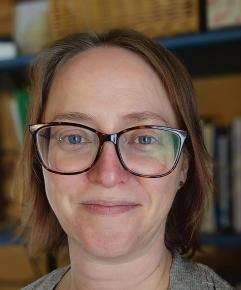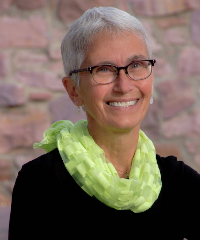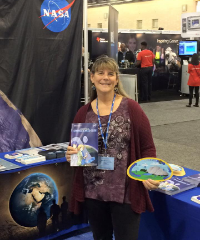Community Blogs
Community Blogs
Discover how the GLOBE community is engaging in all things GLOBE through the community blog posts below.
Learn how to create a GLOBE community blog post.
Filter By:
Blogs List
Discover the Wonders of the World’s Forests!
Greetings, middle and high school educators! Are you ready to bring
the wonders of forests into your classroom? Dive into this blog series
that bridges the resources of Natural Inquirer and the GLOBE Program,
designed to inspire curiosity, scientific exploration, and
environmental stewardship among your students.
GLOBE and Natural Inquirer Crosswalk
This series is part of the
GLOBE
and Natural Inquirer Crosswalk Project , which connects the
hands-on science of the GLOBE Program with the captivating research
found ...
Read More »
Posted in:
Curriculum:
SCIENCE AND MATH
GLOBE Science Topics:
CLIMATE
CLIMATE CHANGE
EARTH AS A SYSTEM
Investigation Areas:
EARTH AS A SYSTEM
PRECIPITATION
AIR TEMPERATURE
SURFACE TEMPERATURE
BIOMETRY (INCLUDING TREE HEIGHT)
LAND COVER CLASSIFICATION
CARBON CYCLE
Primary Audience:
TEACHERS
Teacher's Guide:
MIDDLE: 6-8
SECONDARY: 9-12
Audience
Middle school and high school
Time
Approximately 2 class periods:
Day 1 : Explore the role of forests in the carbon cycle
through reading and analyzing charts and images.
Day 2 : Engage with GLOBE resources and interactive learning
tools for hands-on discovery.
Materials
The
World’s Forests 2 (pdf), Inquiry 4
Carbon
Travels Game (pdf)
Optional: GLOBE Carbon
Cycle protocols
Optional: My NASA Data pacing guide Trees
and the Carbon Cycle (pdf)
What do the world’s forests have to ...
Posted in:
Curriculum:
SCIENCE AND MATH
GLOBE Science Topics:
CLIMATE
CLIMATE CHANGE
GLOBE PROTOCOLS
EARTH AS A SYSTEM
Investigation Areas:
CARBON CYCLE
Primary Audience:
TEACHERS
Teacher's Guide:
MIDDLE: 6-8
SECONDARY: 9-12
Audience
Middle school and high school
Time
Approximately 2 class periods:
Day 1 : Analyze the Natural Inquirer inquiry, focusing on
charts and text.
Day 2 : Use GLOBE tools to explore real-world data and trends.
Materials
The
World’s Forests 2 (pdf), Inquiry 5
Data
Visualization System
Advanced
Data Access Tool
Steps
in the Scientific Process
How well are we managing our forests worldwide?
Forest managers take many factors into consideration when making
decisions. In recent ...
Posted in:
Curriculum:
SCIENCE AND MATH
GLOBE Science Topics:
CLIMATE
CLIMATE CHANGE
GLOBE PROTOCOLS
EARTH AS A SYSTEM
Primary Audience:
TEACHERS
Teacher's Guide:
MIDDLE: 6-8
SECONDARY: 9-12
Our project for SEES 2024 was "Creating a Model to Identify
High-Risk Areas for Flash Flooding in Houston, Texas." In this
blog, I will discuss how we calculated which areas are "high-risk."
There are many ways to identify the most at-risk points of flooding
in a given region. Such points are commonly identified in a flood map,
such as the one here:
For our project, we decided to look at elevation data, which is
perhaps the most intuitive: water flows downhill and will accumulate
in the lowest regions. To get our elevation data, we used ...
Posted in:
GLOBE Science Topics:
CLIMATE CHANGE
EARTH AS A SYSTEM
EARTH SYSTEM SCIENCE
Investigation Areas:
EARTH AS A SYSTEM
BIOSPHERE
LAND COVER CLASSIFICATION
Primary Audience:
SCIENTISTS
STUDENTS
TEACHERS
Student Research Reports:
MISSION MOSQUITO REPORT
El 25 de septiembre de 2015, los líderes
mundiales adoptaron un conjunto de objetivos globales para erradicar
la pobreza, proteger el planeta y asegurar la prosperidad para todos
como parte de una nueva agenda de desarrollo sostenible. Cada objetivo
tiene metas específicas que deben haberse alcanzado para el año 2030.
Para alcanzar estas metas, todo el mundo tiene que hacer su parte: los
gobiernos, el sector privado, la sociedad civil y personas como
nosotros (ONU).
Es por esta razón que el encuentro de
hoy tuvo como propósito principal establecer con cuales de los 17 ...
Posted in:
Curriculum:
EDUCATION RESEARCH
GLOBE International STEM Network (GISN):
GLOBE INTERNATIONAL STEM NETWORK (GISN)
GLOBE Mission Earth News:
STUDENT RESEARCH & ACTIVITIES
GLOBE Science Topics:
CLIMATE CHANGE
Investigation Areas:
BIOSPHERE
Retomando nuevamente los encuentros luego de un corto período de
vacaciones de sus miembros.
En esta ocasión se plantearon varios interrogantes, con base en la
situación priorizada, para estructurar la pregunta de investigación a
la cual se le dará respuesta con el desarrollo de la investigación.
Posted in:
Curriculum:
EDUCATION RESEARCH
Field Campaigns:
CARBON CYCLE
GLOBE International STEM Network (GISN):
GLOBE INTERNATIONAL STEM NETWORK (GISN)
GLOBE Mission Earth News:
STUDENT RESEARCH & ACTIVITIES
GLOBE Science Topics:
CLIMATE CHANGE
Investigation Areas:
BIOSPHERE
The GLOBE Clouds team is delighted to announce this new section that showcases sky and cloud photographs from around the world! We’ve also been receiving some amazing questions from students.
The featured question was asked by students from Corpus Christi Catholic School :
Question: Why can we see clouds but not evaporation?
Answer: Water vapor is invisible. However, the water in clouds is in liquid or solid state, not gas.
Do you have a favorite cloud photo or a question for the team? Use the linked form to cast your vote and ask us any question ...
Posted in:
Curriculum:
STEM
GLOBE Science Topics:
BACKYARD SCIENCE
CLIMATE
CLIMATE CHANGE
GENERAL SCIENCE
GENERAL SCIENCE @ES
EARTH AS A SYSTEM
EARTH SYSTEM SCIENCE
Investigation Areas:
ATMOSPHERE
EARTH AS A SYSTEM
News Topics:
NEWS BRIEFS
Primary Audience:
ALUMNI
COUNTRY COORDINATORS
PARTNERS
SCIENTISTS
STUDENTS
TEACHERS
TRAINERS
Waleska works with in-service teachers in the teacher training programs of the Galileo University and the University of San Carlos of Guatemala. She is the founder and coordinator of the STEAM program
Question: Where are you from?
Answer: I was born in the city of the eternal Spring, Guatemala City, in Central America, several eclipses, comets, and moons ago.
Question: What inspired you to work in this field?
Answer: Since I was little I had a fascination with natural phenomena, the reason why stars shine led me to be a Physicist, and fireflies and ...
Posted in:
Curriculum:
STEM
GLOBE Science Topics:
BACKYARD SCIENCE
CLIMATE
CLIMATE CHANGE
DATA INCLUDED
GENERAL SCIENCE
GENERAL SCIENCE @ES
SCIENTIST SKILLS
Investigation Areas:
ATMOSPHERE
EARTH AS A SYSTEM
Primary Audience:
ALUMNI
COUNTRY COORDINATORS
PARTNERS
SCIENTISTS
STUDENTS
TEACHERS
TRAINERS
Brad Hegyi is a research scientist for the NASA Prediction of Worldwide Energy Resources (POWER) project team at Langley Research Center in Hampton, Virginia, USA. Brad develops metrics and statistics for POWER from model estimates of future climate to help support planning for future energy use by heating and cooling systems in buildings. Brad also helps create interactive data products to better visualize changes occurring in the climate data.
The energy that comes from the Sun is the basic source of energy for everything on Earth. Solar energy drives Earth’s weather and ...
Posted in:
Curriculum:
TECHNOLOGY
STEM
GLOBE Science Topics:
BACKYARD SCIENCE
CLIMATE
CLIMATE CHANGE
DATA INCLUDED
GENERAL SCIENCE
EARTH AS A SYSTEM
EARTH SYSTEM SCIENCE
SCIENTIST SKILLS
Investigation Areas:
ATMOSPHERE
EARTH AS A SYSTEM
Primary Audience:
ALUMNI
COUNTRY COORDINATORS
PARTNERS
SCIENTISTS
STUDENTS
TEACHERS
TRAINERS
The Sun drives many processes in Earth’s atmosphere. As the Sun rises and sets, it warms the Earth’s surface at different intensities. These changes in heat lead to changes in the clouds, especially the types of clouds. To study these changes, we need observations at different times over the course of hours, days, weeks, months, and years from around the globe. It can be tricky to capture the extent of these interactions with satellites alone, which is why we need observations from your perspective on the ground as part of the GLOBE Eclipse Challenge: Clouds and Our ...
Posted in:
Curriculum:
STEM
GLOBE Science Topics:
BACKYARD SCIENCE
CLIMATE
CLIMATE CHANGE
DATA INCLUDED
GENERAL SCIENCE
GLOBE PROTOCOLS
EARTH AS A SYSTEM
Investigation Areas:
ATMOSPHERE
EARTH AS A SYSTEM
Energy from the Sun warms our planet, and changes in sunlight can also cause changes in temperature, clouds, and wind. Clouds are ever changing and give you clues and information on what is happening in the atmosphere. Eclipses provide a natural experiment, in which the Sun’s light is blocked from Earth for a brief period in time, allowing us to observe the effects of that sudden change. Read the newly released blog post explaining in depth cloud formation and which ones would be impacted by the upcoming total solar eclipse over North America and how the data will be used. ...
Posted in:
Curriculum:
STEM
GLOBE Science Topics:
BACKYARD SCIENCE
CLIMATE
CLIMATE CHANGE
GLOBE PROTOCOLS
EARTH AS A SYSTEM
Investigation Areas:
ATMOSPHERE
CLOUDS
EARTH AS A SYSTEM
Primary Audience:
ALUMNI
COUNTRY COORDINATORS
PARTNERS
SCIENTISTS
STUDENTS
TEACHERS
TRAINERS
The NASA GLOBE Clouds Quarterly Update is available for December, January, February 2023-2024!
Coming Soon: Cloud Challenge 2024
The team is excited to announce that in 2024 we will have a Cloud Challenge focused on how clouds change throughout the day.
First Long-Duration Lidar Satellite Mission CALIPSO Ends
CALIPSO (Cloud-Aerosol Lidar and Infrared Pathfinder Satellite Observations), a lidar satellite that advanced the world’s understanding of climate, weather, and air quality, ended its scientific mission on August 1, 2023 after 17 years of operation.
Meet an ...
Posted in:
GLOBE Science Topics:
BACKYARD SCIENCE
CLIMATE
CLIMATE CHANGE
GLOBE PROTOCOLS
Investigation Areas:
ATMOSPHERE
CLOUDS
News Topics:
NEWS BRIEFS
Primary Audience:
ALUMNI
COUNTRY COORDINATORS
PARTNERS
SCIENTISTS
STUDENTS
TEACHERS
TRAINERS
Hey everyone! Our names are Emily and Caitlin! We are future educators, who are working hard to gain all the necessary experience and knowledge to be the best teachers we can be for our students. When looking at Natural Inquirer and GLOBE, we found a common theme, climate change. We chose this topic because we found it to be relevant to what is happening in our world today. Climate change is something that will impact everyone over time; it will bring challenges to each of our lives. It is important to realize that climate change has been impacting different animals, plants and ...
Posted in:
GLOBE Science Topics:
CLIMATE CHANGE
Primary Audience:
PARTNERS
TEACHERS
Teacher's Guide:
UPPER PRIMARY: 3-5
One of the things that I find the most inspiring about The GLOBE Program , is the rich collaboration that it enables us to have with each other. Speaking for myself, I now have friends literally all around the globe, because of my engagement and interaction with GLOBE. I thought I would take a little time to write about a very inspiring intergenerational collaboration that I have found particularly enriching.
During the virtual GLOBE Annual Meeting in 2021, I was asked by a participant if we could meet up in a virtual room and chat. I was astonished to meet the extremely vibrant ...
Posted in:
Curriculum:
EDUCATION RESEARCH
LANGUAGE CULTURE AND ARTS
SCIENCE AND MATH
TECHNOLOGY
STEM
Field Campaigns:
GPM
GLOBE International STEM Network (GISN):
GLOBE INTERNATIONAL STEM NETWORK (GISN)
GLOBE Science Topics:
BACKYARD SCIENCE
CLIMATE
CLIMATE CHANGE
DATA INCLUDED
GENERAL SCIENCE
GLOBE PROTOCOLS
EARTH AS A SYSTEM
EARTH SYSTEM SCIENCE
SCIENTIST SKILLS
MEETINGS/CONFERENCES
Investigation Areas:
ATMOSPHERE
HYDROSPHERE
EARTH AS A SYSTEM
PEDOSPHERE (SOIL)
BIOSPHERE
Learning Activities:
ATMOSPHERE AND CLIMATE
EARTH AS A SYSTEM
HYDROLOGY
LAND COVER/BIOLOGY
SOIL
Primary Audience:
ALUMNI
COUNTRY COORDINATORS
PARTNERS
SCIENTISTS
STUDENTS
TEACHERS
TRAINERS
Hi everyone! Our names are Grace, Olivia, and Logan! We are future elementary school educators looking to gain the necessary skills and knowledge to support our students and be the best educators we can be. When we were tasked with looking at Natural Inquirer and GLOBE resources, we found much information on climate change and how it affects our planet. We wanted to choose a topic that we thought could relate to our lives; climate change continues to be one of the largest issues we face today. As we will be teaching for a long time to come, it is essential we understand this topic in ...
Novedades trimestrales de NASA GLOBE Clouds
Diciembre/Enero/Febrero 2022-2023
Las novedades trimestrales de NASA GLOBE Nubes 2022-2023 están disponibles.
Anuncio acerca de NOAA-20
En 2023, será posible hacer coincidir tus observaciones satelitales con un nuevo satélite. Obtén más información sobre NOAA-20 y cómo aumentar la posibilidad de obtener una coincidencia con satélites.
NASA GLOBE CLOUD GAZE termina en 2022
Después de lograr una increíble cantidad de clasificación de fotos del cielo, NASA GLOBE CLOUD GAZE está llegando a su fin; sin embargo, puedes conocer ...
Posted in:
GLOBE International STEM Network (GISN):
GLOBE INTERNATIONAL STEM NETWORK (GISN)
GLOBE Science Topics:
BACKYARD SCIENCE
CLIMATE
CLIMATE CHANGE
GENERAL SCIENCE @ES
GLOBE PROTOCOLS
EARTH AS A SYSTEM
EARTH SYSTEM SCIENCE
GLOBE Working Groups:
SCIENCE WORKING GROUP
Investigation Areas:
ATMOSPHERE
CLOUDS
EARTH AS A SYSTEM
News Topics:
NEWS BRIEFS
Primary Audience:
ALUMNI
COUNTRY COORDINATORS
PARTNERS
SCIENTISTS
STUDENTS
TEACHERS
TRAINERS
The NASA GLOBE Clouds Quarterly Update is available for winter 2022-23!
NOAA-20 Announcement
In 2023, it will be possible for you to match your satellite observations with a new satellite. Learn more about NOAA-20 and how to increase the chance to get a satellite match.
NASA GLOBE CLOUD GAZE Ends in 2022
After achieving an incredible number of sky photos’ classification, NASA GLOBE CLOUD GAZE is coming to an end, but you can learn about its success stories and download its data in this year-end report.
Cloud Observation Tip: Cloud Iridescence
Cloud iridescence occurs ...
Posted in:
GLOBE International STEM Network (GISN):
GLOBE INTERNATIONAL STEM NETWORK (GISN)
GLOBE Science Topics:
BACKYARD SCIENCE
CLIMATE
CLIMATE CHANGE
EARTH SYSTEM SCIENCE
GLOBE Working Groups:
SCIENCE WORKING GROUP
Investigation Areas:
ATMOSPHERE
CLOUDS
EARTH AS A SYSTEM
News Topics:
NEWS BRIEFS
Primary Audience:
ALUMNI
COUNTRY COORDINATORS
PARTNERS
SCIENTISTS
STUDENTS
TEACHERS
TRAINERS
Uno de los momentos más emocionantes al realizar una observación de nubes es recibir tu correo electrónico personalizado de la NASA. El correo electrónico incluye datos sobre tu observación, hora y ubicación, y los compara con los datos obtenidos por satélites aproximadamente al mismo tiempo y en tu ubicación.
Comprensión de las tres partes de tu tabla de coincidencias con satélites: general, detallada e imágenes
Para cada sección, observa las comparaciones generales entre tu reporte y los datos resultantes. Recuerda, tu punto de vista del cielo (desde el suelo mirando hacia ...
Posted in:
Curriculum:
LANGUAGE CULTURE AND ARTS
SCIENCE AND MATH
STEM
GLOBE International STEM Network (GISN):
GLOBE INTERNATIONAL STEM NETWORK (GISN)
GLOBE Science Topics:
BACKYARD SCIENCE
CLIMATE
CLIMATE CHANGE
GENERAL SCIENCE
GLOBE PROTOCOLS
EARTH AS A SYSTEM
EARTH SYSTEM SCIENCE
Investigation Areas:
ATMOSPHERE
EARTH AS A SYSTEM
News Topics:
NEWS BRIEFS
The NASA GLOBE Clouds Quarterly Update is available for September/October/November 2022!
Match to a Million Satellite Matches Celebration
Thanks to you, The GLOBE Program has reached one million satellite observations matched to your cloud reports! Share in the celebration and thank you videos made just for you.
GLOBE Clouds New Satellite Matching: NOAA-20
The NASA GLOBE Clouds team will soon be adding NOAA-20 to our satellite matching capabilities. Learn more about NOAA-20 and updates to the GLOBE Clouds satellite matching schedule.
Meet an Expert: Naudia Graham ...
Posted in:
Curriculum:
SCIENCE AND MATH
GLOBE International STEM Network (GISN):
GLOBE INTERNATIONAL STEM NETWORK (GISN)
GLOBE Science Topics:
BACKYARD SCIENCE
CLIMATE
CLIMATE CHANGE
GLOBE PROTOCOLS
EARTH AS A SYSTEM
Investigation Areas:
ATMOSPHERE
CLOUDS
Did you know that clouds can both warm and cool our planet? Keeping an eye on clouds helps NASA study our climate. You can notice some of these changes by just looking at the clouds.
Here are some examples you might have already noticed:
Do all clouds cast shadows? Low thick clouds tend to cast the most shadows. The shadows show you how the cloud is blocking the light from the sun from reaching the ground. This is similar to you placing your hand in front of your eyes when it is too sunny. Your hand is blocking the light from reaching your eyes. This is the same as the ...
Posted in:
Curriculum:
SCIENCE AND MATH
STEM
GLOBE Science Topics:
BACKYARD SCIENCE
CLIMATE
CLIMATE CHANGE
GENERAL SCIENCE
GLOBE PROTOCOLS
EARTH AS A SYSTEM
SCIENTIST SKILLS
Investigation Areas:
ATMOSPHERE
Primary Audience:
ALUMNI
COUNTRY COORDINATORS
PARTNERS
SCIENTISTS
STUDENTS
TEACHERS
TRAINERS
—
20 Items per Page










